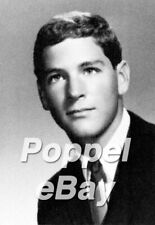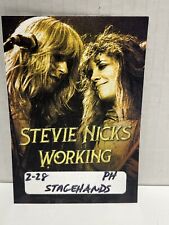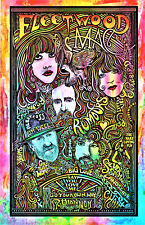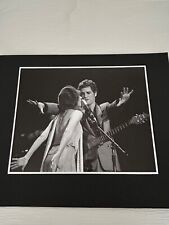|
Guitar World, No Easy Tusk Guitar World, May 1989 No Easy Tusk
After years of journeymen status, RICK VITO and BILLY BURNETTE breathe life into a new-and-improved Fleetwood Mac. By Richard J. Grula Replacing a crucial member in one of the world's most popular bands can be an unnerving experience - just ask Billy Burnette and Rick Vito. The two guitarist/singers were selected by drummer Mick Fleetwood to fill the void created by Lindsey Buckingham's departure from Fleetwood Mac. Though qualified and ready for the task at hand, Vito and Burnette's trial-by-fire introduction on Mac's Shake The Cage world tour sent more than a few shivers down their veteran spines. "It was a little scary before we played that first show in Kansas City," recalls the ordinarily cool Burnette. "I'd wake up at night sweating, going, 'Oh mannnn . . .' I could just see Rick and I getting jousted about the arena by fans. And I'd hear stuff second-hand from people, saying, 'I'd hate to be in his shoes. The critics are just going to rip him apart.' But it was just the opposite when we played - a lot of people said the band had never sounded so good. That made it a lot easier on me and Rick. We knew we had a killer band." That killer band is best showcased on the new long-play concert video, Tango In The Night. The video captures a energetic and surprisingly happy Fleetwood Mac - mighty impressive, considering the traumas they've suffered in recent years. With Vito's tasty riffs at the forefront, the group confidently pushes past its terminally laid-back Southern California groove and regains its old rocking blues sound (witness Burnette's rave-up rendition of "Oh Well" and Vito's reverent treatment of "Another Woman," two blues classics from the early Peter Green era Mac.) Though a Buckingham-less Fleetwood Mac once seemed unthinkable, the advantages of the new line-up are obvious. By injecting the blues/roots rock stylings of Vito and Burnette, Mick Fleetwood has shrewdly readied his band for the future by reintroducing its past. Rick Vito acquired his bluesy chops in suburban Philadelphia, where his father was in the nightclub business. "He always had a taproom with a jukebox," remembers Vito. "Back then, the supplier would give you free records. Once the new songs came in, the old ones came out, so we always got an endless selection. I still have a whole bunch of them, like the original Little Richard 45's." After learning the basics on a Stella acoustic, Vito laid his hands on a single-pickup Gibson hollow-body, and later and Gretsch "Twist Guitar." "I'd love to have that now," he says of the Twist. Though he made occasional attempts at formal lessons, Vito always quit and came back to his record collection. Growing up in the early sixties, he had musical influences that were fairly standard. "When you start playing at that point in time, you learn Ventures tunes, Chuck Berry stuff, James Burton - basic rock'n'roll guitar, blues guitar, kind of one-time removed. When the Stones came out, I bought all of those records and learned every lick Keith Richards played." His obsession with the Stones led Vito to the classic blues players; by the time he was in college, he was a hardcore "blues purist." He formed a band and began playing the college circuit semi-professionally. But the young guitarist realized that music was his destiny in December, 1968, after he attended a performance by the original Fleetwood Mac at the Electric Circus in Philadelphia. "I went with some friends and we sat in the second row, right in front of Peter Green," he recalls. "They were really tremendous. I drove the nail all the way in. I immediately started writing songs, although listening back now, they were pale imitations of Peter Green songs." Billy Burnette's choice of musical career didn't take as long as Vito's. Born in Memphis and raised in Hollywood, Burnette was the son of rockabilly legend Dorsey Burnette - co-founder of the Rock and Roll Trio, along with brother Johnny. He made his performance debut at the age of three-and-a-half, joining his father's group onstage for a preschooler's impersonation of Elvis. His record debut came at age seven as "Young Billy Bo," on a Christmas single for Dot Records, recorded with James Burton and Ricky Nelson's band (Dorsey and Johnny wrote many of Ricky Nelson's early hits). He picked up the guitar at age thirteen, after touring the Far East with singer Brenda Lee. Instead of lessons, he simply sat in the family living room and kept his ears open. "I'd learn from people hanging around the house," Burnette says. "There were always great players coming around: Glen Campbell, Roger Miller, James Burton. I learned to play on a baby Martin acoustic that my father used to take around in the car with him. My first electric was probably a Telecaster." Signing with producer Chips Moman as a staff songwriter a week after graduating from high school, Burnette moved back to Memphis, where he cut an album for Columbia in 1971. Though he was making his mark as a singer and songwriter, Burnette continued honing his guitar chops, finding particular inspiration in the playing of Delaney Bramlett, of Delaney and Bonnie. "It was different," he explains. "A mixture of country, blues, rock - it had a little bit of everything." Interestingly, Vito discovered the r&b-influenced rock'n'roll of Delaney and Bonnie at roughly the same time. "It was the only thing out there at the time I could relate to that wasn't strict blues," Vito says. Armed with his own band's demo tapes and modest hopes, Vito showed up at a Delaney and Bonnie gig and introduced himself to the couple. "I was just looking for a little encouragement or direction, and I got to jam with them," he recalls with a laugh. "They encouraged me to move to Los Angeles and do it full-time, which I did in '71. As it happened, Delaney and Bonnie hired me, and that was my first pro sideman gig." The Delaney and Bonnie job led to a decade-plus of regular gigging for Vito, including stints with Bobby Whitlock, Little Richard, John Mayall, Roger McGuinn, Bonnie Raitt, Jackson Browne and Bob Seger, not to mention his solo projects. He attributes this steady flow of work to "a certain versatility and taste I have in my playing. And I've never strayed too far from a roots-oriented style - I've never really jumped on fads or tried to pick up on modern things. I suppose attitude's also had a bit to do with it. I've always been kind of low-key, which has been both a help and a hindrance." Meanwhile, Burnette was busy with his own burgeoning career. In addition to writing songs for artists like Jerry Lee Lewis, the Everly Brothers, Charlie Rich and Conway Twitty, Burnette registered some near-misses with his rockabilly solo records of the late seventies and early eighties. It was a matter of bad timing. "We made a big deal with CBS, one of the biggest every made," he remembers. "They worked the record for a while and we almost busted through, but they said, 'We don't think radio's ever gonna play rockabilly again.' A year later the Stray Cats came out, doing my dad's songs!" Burnette met drummer Mick Fleetwood during the shooting of Dick Clark's 5th Anniversary Special. A few months later, Fleetwood invited Billy to join his pet project, The Zoo, which released an album on RCA in 1982. Billy soon fell in with the entire Fleetwood Mac circle - he began writing songs with Christine McVie and Stevie Nicks and backed Lindsey Buckingham during a performance on Saturday Night Live (this was supposed to be the debut of what became The Zoo.) Burnette and Vito became aware of one another as each played the L.A. club circuit. Though the guitarists pledged for years to jam together, nothing developed until Vito took matters into his own hands. "I went over to my friend's house and he was going to play on a demo session for Billy that night," says Vito. "I said, 'This is ridiculous! I'm gonna call that guy on the phone and tell him I'm coming to his session. I don't care if he likes me or not!'" Luckily, Burnette just happened to be short one lead guitarist that day and Vito's call came in the nick of time. At the session, Vito met drummer Mick Fleetwood. Fleetwood obviously liked what he heard and filed away Rick's name. Three years later, Fleetwood and Billy sat in at a Rick Vito and Blues Moderne club gig in L.A. Three weeks later, on the eve of the Mac's first tour in years, Buckingham departed and Fleetwood placed the calls. "It was one of those things that wasn't set up as an audition, but really was," explains Vito. "There wasn't any talk of other players, because Mick definitely felt this would be a good combination." It didn't take long for Burnette and Vito to prove Fleetwood right. According to Burnette, who had already discussed joining Mac as a touring rhythm guitarist/singer, "We went through about five things at the rehearsal, stopped and the band went into a quick little huddle. Then they came over to us and said, 'You wanna join the band?' It was pretty heavy duty." In dividing Fleetwood Mac guitar duties, Burnette sticks to rhythm, providing selfless support for Vito's leads and fills. Vito claims to approach the band's guitar arrangements the same way he has in other situations. "Basically, I find the key licks, keep them in and embellish everything else with my own thing. For instance, I put in a lot more slide guitar now." Even so, this new version of the band has the ability to more closely recreate the sounds of classic Fleetwood Mac recordings. As Burnette points out, "Lindsey was the only guitar player live, and a lot of those records had two or three guitars which really make them happen. Now, we're able to divide it and cover all the parts, so people get even more of a taste of the records." In the studio and on the Shake The Cage tour, Burnette played a Strat-style Epiphone F-400 electric, as well as two Gibson Les Paul Lites ("they're great live, because they don't tear your shoulder off"). Amplification was supplied by several Seymour Duncan amps, and processing was limited to a Roland GP-8 multi-effects floor unit. Vito's main axes include a customized Telecaster with humbuckers in the neck and bridge positions and a single-coil in the middle, a Ripley stereo guitar, a 1956 Les Paul Junior for slide and a stunning, art-deco, six-string electric designed by Vito and built by Toru Nittono at L.A. Guitar Works. "I've gone through the whole collector sickness," he smirks, "and now I really want guitars that are a totally personal expression." Nittono should have Vito's second design, an instrumental featuring Strat-style electronics and another art-deco finish, completed in time for the new Fleetwood Mac album. For amplification, Vito plugs into one hundred and fifty-watt Dumble heads and 2 x 12-inch cabinets with EV speakers. He also uses the Roland GP-8 for processing. "I can't get into all those effects," he sighs. "You start losing the original signal - especially in recording. There's something to be said for 'straight into the amp.' There's a clarity there, so it's better to add effects after. Just record it straight for a big, fat sound." This plug-it-in-and-play approach will no doubt be appreciated by those band members tired of Buckingham's fanatical and time-consuming attention to detail in the studio. Though the classic Mac sound is preserved on "As Long As You Follow" and "No Questions Asked," two songs by the new line-up on the Best of Fleetwood Mac, there is a live vibe to the recordings - a vibe which both Vito and Burnette want to bring into the Fleetwood Mac album currently being recorded. "People keep asking what the new record's going to be like," says Burnette. "I think it's going to be a big surprise to all of us. We're going to be more like a live band on this record. On the last two songs, we put down the tracks as a band. Not a lot had to be done after that. Plus, we've talked about doing some real rock'n'roll. If there's a space where something like that would fit, I'd love to do it." "What I'd like to contribute to the new band," adds Vito, "is a reintroduction of blues, but the kind of sound from which they started. There's a lot of possibilities that we haven't explored yet, and we won't be able to do so until we get into the studio." Thanks to Rick Vito for sending this to the Penguin, Les for posting it to the Ledge, and to Anusha for formatting and sending it to us.
|









